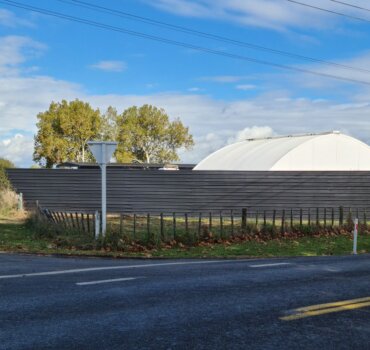
The corrugated iron fence residents say is not in keeping with the rural environment in Kaipaki.

The corrugated iron fence residents say is not in keeping with the rural environment in Kaipaki.
The conflict between rural-based industries and lifestylers is something Waipā District Council says is not uncommon – and the latest example is in Kaipaki.
Agricultural contractor Karl Schwitzer has resource consent to operate a contractors’ yard for cutting and supplying hay to farmers. He also has permission to put a new shed on the site at the intersection of Goodwin and Kaipaki Road opposite the primary school.
But some Kaipaki residents are unhappy saying Schwitzer has built an ugly corrugated iron fence which is higher than what he has consent for and two additional shed bays are larger than what was shown in the consent.
They also say Schwitzer plans to move the former Bunnings building onto the site which would be an inappropriate building for Kaipaki and not in keeping with the rural zone.
Schwitzer acknowledged the fence at 2.5m is higher than the allowed 1.8m high but says he put it up because burglars scaled the smaller fence he had, cut open 55 bales of hay and stole them.
The fence was silver but this week he painted it black so it would blend in with a nearby hedge.
“The fence is no bigger than the hedge,” he said.
“Now it looks pretty smart.”
Schwitzer also said the council had visited his yard three weeks and said the shed bays comply with his resource consent.
He confirmed he had asked the council about the possibility of moving part of the old Bunnings building out to the yard for a storage shed but nothing had come of it yet.
“I understand you’ve got to comply with the rules,” said
Schwitzer who acknowledged the conflict between businesses like his and rural lifestylers.
“I can understand from their point of view.”
He said he supported the community by recently felling 12 big poplar trees from the school grounds.
Waipā district plan and growth manager Tony Quickfall said lifestylers often have expectations of a rural amenity which differ from the District Plan.
Rural zone rules, approved through the public process of reviewing the District Plan, reflect the rural environment is a “working environment” which permits a range of commercial activities and associated noise and visual effects, he said.
“If there is evidence that permitted land use activities are giving risk to significant adverse effects, the Resource Management Act provides for plan changes to the District Plan,” said Quickfall.
“The council does not have evidence of any district-wide trends or cumulative significant effects in the rural zones that would justify a plan change.”
If Schwitzer’s fence was higher than 1.8m, it would breach the District Plan rules and must be removed or he would have to obtain a resource consent.
Quickfall said a planner last visited the site on April 13 last year to process the original application which was to establish a rural based industry, build a workshop storage shed, one implement shed and move an industrial building from 13 Matos Segedin Drive.








